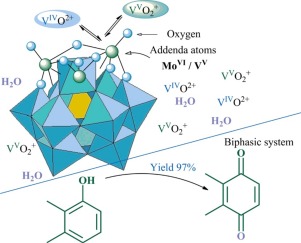Applied Catalysis A: General ( IF 4.7 ) Pub Date : 2017-10-09 , DOI: 10.1016/j.apcata.2017.09.022 Yulia A. Rodikova , Elena G. Zhizhina , Zinaida P. Pai

|
2,3-Dimethyl-p-benzoquinone (2,3-Me2BQ) is a valuable chemical that is applied as a soft oxidizing and dehydrogenating agent and also as a synthon in preparing different complex products including pharmaceutical and biochemical substances. Keggin- and modified-type aqueous solutions of Mo-V-phosphoric heteropoly acids (Mo-V-P HPAs) with the gross compositions H3+xPMo12-xVxO40 (HPA-x) and HaPzMoyVx’Ob (HPA-x’), respectively, possessing high oxidation potential and simplicity of regeneration can serve as effective soft oxidants for obtaining such para-quinone from 2,3-dimethylphenol (2,3-Me2P). The synthesized HPA catalysts with different vanadium content were characterized by a number of analysis techniques, such as 31P and 51V NMR spectroscopy, potentiometry, titrimetry, and pH measurement. It was found that the predominant formation of 2,3-Me2BQ instead of corresponding diphenoquinone (DPQ) at one-electron oxidation is achieved by a consecutive optimization of reaction conditions, the most important among them being organic solvent and molar ratio of vanadium(V) to substrate. As was shown, the substitution of HPA-x by HPA-x’ allows one to increase the quinone selectivity and to decrease the optimal molar ratio of vanadium(V) to substrate. The highest yield of the desired quinone (97%) at total substrate conversion was obtained by using the biphasic water-benzene system at molar vanadium(V) to substrate ratio of 12. The temperature of 50 °C and an inert atmosphere were established to be the optimal reaction conditions. The aqueous HPA-10′ solution including the highest content of VO2+ ions proved to be the most efficient catalyst among investigated HPAs. Carrying out catalyst regeneration at a separate stage provides the preservation of its activity and selectivity at the initial level for at least ten cycles.
中文翻译:

含钒杂多酸催化2,3-二甲基苯酚转化为对醌的催化方法
2,3-二甲基-对苯醌(2,3-Me 2 BQ)是一种有价值的化学品,可作为软氧化剂和脱氢剂,也可作为合成子用于制备包括药品和生化物质在内的各种复杂产品。具有总组成H 3 + x PMo 12-x V x O 40(HPA-x)和H a P z Mo y的Mo-V-磷酸杂多酸(Mo-VP HPA)的Keggin型和改性型水溶液V X“ ø b(HPA-X”),分别具有高氧化电势和再生的简单可作为用于获得这种有效软氧化剂由2,3-二甲基苯酚(2,3-Me 2 P)生成的对苯二酚。通过多种分析技术,如31 P和51 V NMR光谱,电位法,滴定法和pH测量,对合成的具有不同钒含量的HPA催化剂进行了表征。发现主要形成2,3-Me 2通过连续优化反应条件来实现BQ而不是相应的二苯醌(DPQ)的单电子氧化,其中最重要的是有机溶剂和钒(V)与底物的摩尔比。如图所示,用HPA-x'替代HPA-x可以增加醌的选择性,并降低钒(V)与底物的最佳摩尔比。通过在钒(V)与底物的摩尔比为12的条件下使用双相水-苯体系,在总底物转化率下,所需醌的最高收率(97%)获得。建立了50°C的温度和惰性气氛至是最佳的反应条件。最高VO 2 +含量的HPA-10'水溶液离子被证明是所研究的HPA中最有效的催化剂。在单独的阶段进行催化剂再生可将其活性和选择性保持在初始水平至少十个循环。











































 京公网安备 11010802027423号
京公网安备 11010802027423号